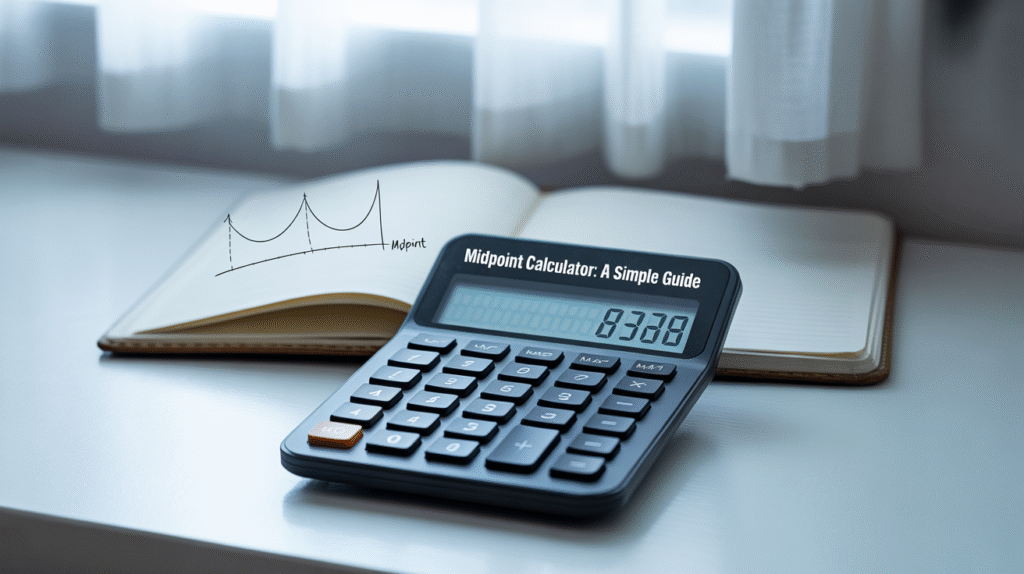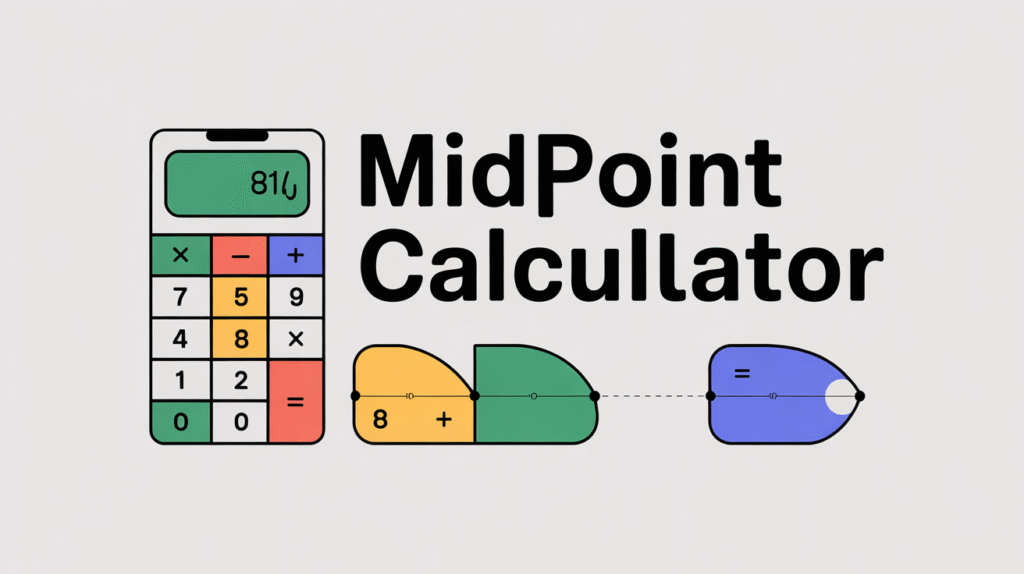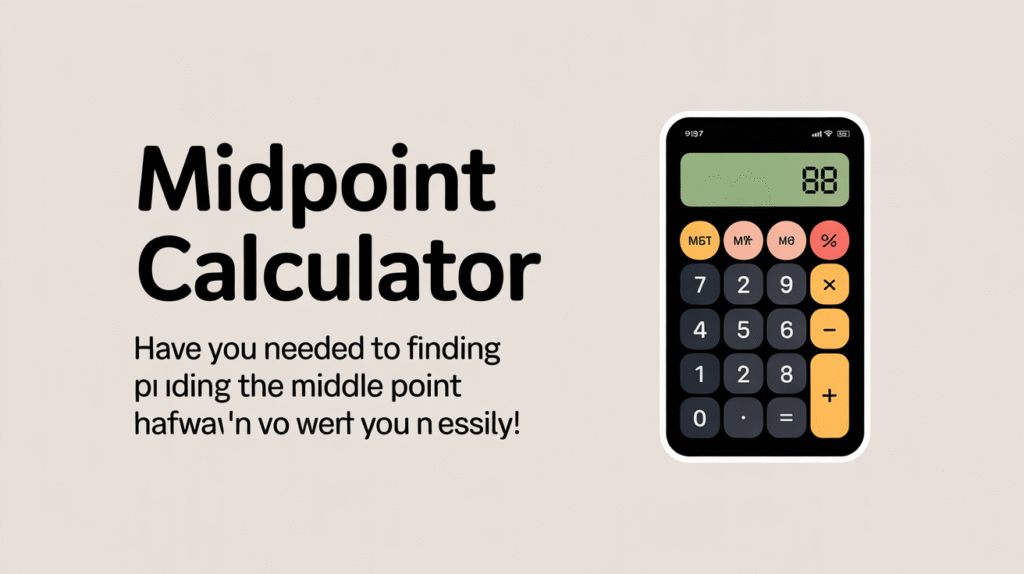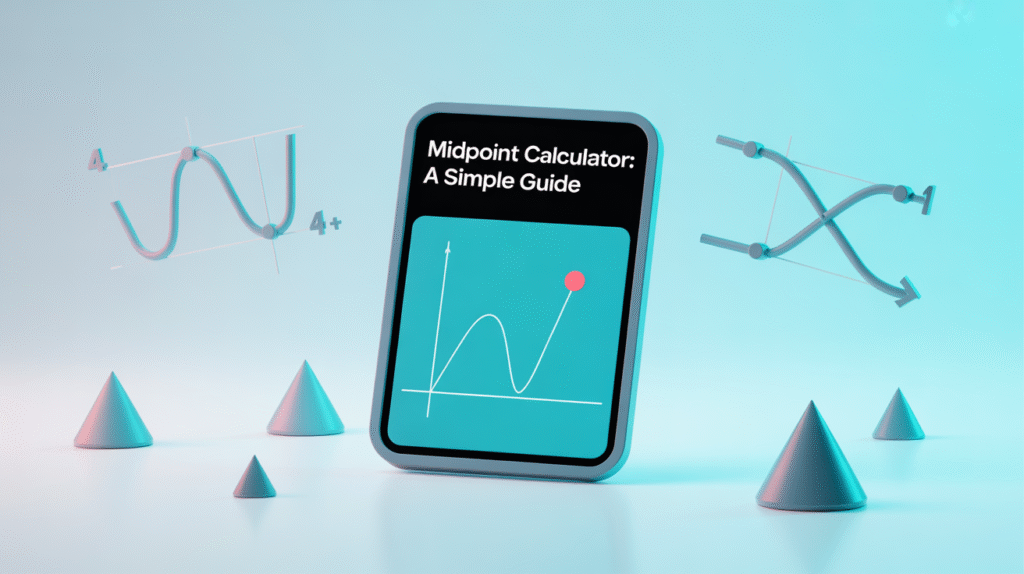Have you ever needed to find the exact middle between two points? Maybe you were drawing a line on graph paper, designing a garden path, or solving a math problem. The midpoint helps you find that “halfway” spot quickly. Thankfully, you don’t need to do it all by hand. A midpoint calculator can do the work for you in seconds!
In this article, we’ll explore what a midpoint calculator is, how it works, and why it’s useful. We’ll also go through step-by-step examples, real-life uses, and a few fun facts. By the end, you’ll know exactly how to use one—and even how to find midpoints on your own.
Table of Contents
What Is a Midpoint Calculator?

A midpoint calculator is a simple online math tool that finds the exact center between two points on a graph or map. It uses the midpoint formula from geometry to figure out the coordinates of the point that lies exactly halfway between them.
You only need to enter the x and y coordinates of the two points. The calculator then shows you the midpoint’s coordinates instantly. No need for long calculations or graph paper!
For example, if you have two points A(2, 4) and B(6, 8), the midpoint is (4, 6). It’s that easy.
The Midpoint Formula Explained Simply
Don’t worry—this formula is very easy once you understand it. The formula for finding a midpoint between two points is: M=(x1+x22,y1+y22)M = \left(\frac{x_1 + x_2}{2}, \frac{y_1 + y_2}{2}\right)M=(2×1+x2,2y1+y2)
Here’s what it means:
- x1x_1x1 and y1y_1y1 are the coordinates of the first point.
- x2x_2x2 and y2y_2y2 are the coordinates of the second point.
- You add the x-values together, divide by two, then do the same for the y-values.
That gives you the exact middle point between them.
Let’s try a quick example:
If you have points (2, 4) and (6, 8): M=(2+62,4+82)=(4,6)M = \left(\frac{2+6}{2}, \frac{4+8}{2}\right) = (4, 6)M=(22+6,24+8)=(4,6)
So, the midpoint is (4, 6).
A midpoint calculator performs this same calculation instantly, saving time and avoiding mistakes.
Why Is the Midpoint Important?

The midpoint is more than just a math concept—it’s used everywhere! Architects use it when designing buildings. Mapmakers use it to find the center between two cities. Even video game designers use midpoint formulas to calculate object placement.
In simple terms, the midpoint helps us balance things. It shows the fair middle between two spots, helping create even distances and symmetry.
Whether you’re studying geometry or building something in real life, knowing how to find the midpoint helps you work more accurately.
How a Midpoint Calculator Works Behind the Scenes
A midpoint calculator uses the same formula we just learned but does it automatically. When you type in two sets of coordinates, the calculator instantly performs the math in the background.
Here’s what it does:
- Adds the x-values.
- Divides the sum by two to find the average x.
- Adds the y-values.
- Divides the sum by two to find the average y.
- Displays the midpoint as a new coordinate pair.
This saves time, especially when you have large or complex numbers. Plus, most calculators can also handle 3D points, which makes them useful in physics, 3D modeling, and computer graphics.
Real-Life Examples of Midpoint Calculations

1. Finding the Middle of a Line
Suppose you’re drawing a line from (3, 5) to (9, 11). To find the center, plug the numbers into the formula: M=(3+92,5+112)=(6,8)M = \left(\frac{3+9}{2}, \frac{5+11}{2}\right) = (6, 8)M=(23+9,25+11)=(6,8)
So the midpoint is (6, 8).
2. Planning a Meet-Up Spot
Imagine you live in one city and your friend lives in another. You both want to meet halfway. A midpoint calculator can find the perfect meeting point using the cities’ coordinates.
3. Designing a Room Layout
Interior designers use midpoints to center furniture or artwork perfectly on walls. The midpoint formula ensures everything looks balanced.
These examples show how useful this simple math concept can be!
How to Use a Midpoint Calculator Step-by-Step
Using an online midpoint calculator is super easy. Follow these steps:
- Open a midpoint calculator in your web browser.
- Enter the first point’s coordinates. Example: (2, 3).
- Enter the second point’s coordinates. Example: (8, 9).
- Click “Calculate.”
- The result will show the midpoint instantly!
That’s it—no pen, no paper, no confusion. You can even try changing the numbers to see how the midpoint moves on a graph.
Midpoint vs. Distance Formula
Some people confuse the midpoint formula with the distance formula, but they are not the same.
- The midpoint formula finds the center between two points.
- The distance formula measures how far apart the two points are.
Both use similar math ideas but give different results. For example:
- Points A(2, 4) and B(6, 8)
- Midpoint = (4, 6)
- Distance = √[(6−2)² + (8−4)²] = √32 = 5.66 units
So, while the midpoint finds the “middle,” the distance formula finds the “length” between the two points.
Applications of Midpoints in Everyday Life
1. Art and Design
Artists often use midpoints to center their drawings or balance shapes. It helps them make everything look even and pleasing.
2. Architecture and Engineering
Builders use midpoints to divide walls, beams, or bridges evenly. It ensures both sides are balanced and safe.
3. GPS and Navigation
When planning routes, midpoints help GPS systems calculate halfway points between two locations.
4. Education and Learning
Teachers use midpoint calculators to show students how geometry works in real-world settings. It turns a hard math concept into something simple and visual.
Midpoints are truly everywhere—even in places you might not expect!
Advantages of Using a Midpoint Calculator
A midpoint calculator offers many benefits:
- Saves Time: No need to calculate by hand.
- Reduces Mistakes: Automatic math means fewer errors.
- Easy to Use: Just type in numbers—no formulas to memorize.
- Handles Complex Data: Works for 2D and 3D coordinates.
- Free and Online: Many tools are free and accessible from any device.
For students, professionals, and everyday users, it’s a small but powerful helper.
Midpoint in 3D Geometry
Did you know you can find a midpoint in three dimensions too? The formula looks similar but includes a z-coordinate: M=(x1+x22,y1+y22,z1+z22)M = \left(\frac{x_1 + x_2}{2}, \frac{y_1 + y_2}{2}, \frac{z_1 + z_2}{2}\right)M=(2×1+x2,2y1+y2,2z1+z2)
This version is used in physics, architecture, and game design, where objects exist in 3D space. A 3D midpoint calculator can quickly show the exact center of two points in 3D.
Tips for Using a Midpoint Calculator Effectively
Here are some quick tips to get the best results:
- Double-check your coordinates. A single wrong number changes the result.
- Use correct formats. Always enter coordinates as (x, y) or (x, y, z).
- Try different examples. Practice helps you understand how midpoints shift.
- Save results. You may need them for projects or reports.
Using these tips ensures accuracy and builds confidence in your math skills.
Common Mistakes When Finding a Midpoint
Even with a calculator, mistakes can happen. Here are some common ones:
- Mixing up x and y coordinates.
- Forgetting to divide by two.
- Using negative signs incorrectly.
- Entering coordinates in the wrong order.
The good news? Most midpoint calculators automatically correct small errors or alert you when something doesn’t look right.
Best Online Midpoint Calculators (2025 Update)
Here are a few reliable options you can try:
- Calculator.net Midpoint Calculator – Simple, fast, and beginner-friendly.
- Symbolab Midpoint Calculator – Great for students with visual explanations.
- GeoGebra Midpoint Tool – Perfect for interactive graphing and learning.
- Desmos Graphing Calculator – Lets you see midpoints on graphs instantly.
These tools all use the same math formula but present results differently. Try a few and see which one fits your style.
Midpoints and Coordinate Geometry
Midpoints are part of a bigger math field called coordinate geometry, where we use numbers to describe shapes and positions. By finding midpoints, distances, and slopes, we can understand lines, circles, and triangles better.
For example, midpoints help in:
- Finding the center of a triangle’s side.
- Locating the center of a circle’s diameter.
- Dividing long line segments into equal parts.
So, learning about midpoints is actually learning one of geometry’s building blocks!
Fun Facts About Midpoints
- The word “midpoint” comes from the Old English words mid (middle) and point (place).
- In nature, many patterns—like leaves or butterfly wings—use symmetry, which relies on midpoint balance.
- You can find a midpoint even on a globe by averaging latitudes and longitudes!
Isn’t it cool how math connects to the real world like that?
Frequently Asked Questions (FAQs)
1. What is a midpoint in simple words?
A midpoint is the point exactly halfway between two other points. It’s like finding the middle of a line.
2. How do you find a midpoint without a calculator?
Add the x-values, divide by two. Then add the y-values, divide by two. That gives your midpoint!
3. Can a midpoint have negative numbers?
Yes! If one or both coordinates are negative, your midpoint can also be negative. It just depends on the positions of your points.
4. What is the difference between midpoint and average?
They are similar ideas. The midpoint is the average of two coordinates. But in geometry, we apply it to points on a graph.
5. Can I use a midpoint calculator on my phone?
Absolutely! Most midpoint calculators work perfectly on mobile browsers. You can find midpoints anywhere, anytime.
6. Why should students learn about midpoints?
Learning about midpoints helps students understand geometry, balance, and coordinate systems. It’s also useful in art, design, and real life!
Conclusion: Find the Middle with Ease
Finding the midpoint doesn’t have to be tricky or time-consuming. Whether you’re a student, designer, or just curious, a midpoint calculator makes it easy to find the perfect halfway point.
By understanding how it works and using it correctly, you can solve geometry problems faster, create balanced designs, and even plan trips smarter.
So next time you need to find “the middle,” try using a midpoint calculator. It’s fast, accurate, and fun to use!



